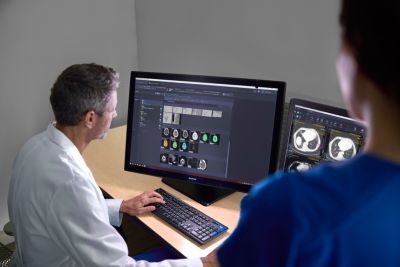
Creating a unified radiology workflow
- By Philips
- July 17 2025
- 6 min read
Radiology departments face growing complexity and inefficiencies due to fragmented software systems. A unified radiology workflow can help to integrate these systems into a single platform, improving access to imaging data and enhancing collaboration among care teams. This streamlined approach boosts diagnostic accuracy, clinician productivity, and ultimately, patient outcomes.
At-a-glance:
- Understand how unified platforms streamline radiology workflows by consolidating systems, reducing inefficiencies, and improving operations
- Explore the benefits of enhanced collaboration and data accessibility with integrated tools that support better communication and reporting
- Learn about the transformative role of AI in case prioritization and automating routine tasks to deliver faster, more accurate diagnoses

Creating a unified radiology workflow solution
Radiology workflows are evolving rapidly, driven by the healthcare industry’s need for not just greater efficiency but also diagnostic accuracy and collaboration. However, the increasing volume and complexity of imaging processes can hamper efficiency and accuracy within radiology departments. Many radiologists and clinicians still must navigate and manage multiple, disparate software systems to find information. This not only hinders workflow but also has the potential to increase errors, care delays and overall workplace frustration. A unified radiology workflow can help solve this complicated challenge. Integrated radiology workflows streamline and consolidate processes to enhance collaboration among care teams, helping to improve both patient outcome and clinician productivity. With a consolidated platform that integrates various systems and tools, radiologists and hospital staff have seamless access to imaging data and reports which is shown to improve communication, collaboration, decision-making and patient care.
What is a radiology workflow?
A radiology workflow refers to the steps involved in an imaging examination, from patient scheduling to report distribution. The key stages of this workflow include:
- Scheduling the patient.
- Capturing and analyzing images.
- Reporting findings and distributing reports to relevant healthcare providers and patients for follow up.
Why is a unified workflow essential?
Traditionally, radiology departments relied on multiple specialized systems for imaging, reporting and data storage. While effective individually, these systems often create information silos, leading to inefficiencies. Consolidating these systems into a single workflow ensures all imaging data, reports, and patient records are accessible in one location, significantly reducing the time spent switching between applications.
Studies have shown that unified workflows address critical challenges through automation and integration, improving efficiency and reducing administrative burdens on radiologists and clinicians. According to the Future Health Index 2024 (FHI), 41% of healthcare leaders are already planning to implement automation for prioritization in the next three years.
Understanding the benefits of a unified radiology workflow
Unified radiology workflows offer transformative benefits across healthcare roles, supporting operational efficiency, collaboration, and patient care. The improvements include:
- Time management: Automation plays a critical role in addressing staff shortages by minimizing manual tasks such as scheduling, case prioritization and routine report generation. The FHI 2024 report found that 92% of healthcare leaders believe automation is essential to address staff shortages in healthcare, allowing professionals to focus on their highest skill level.
- Collaboration and communication: Unified workflows facilitate more seamless communication among radiologists, referring physicians and specialists. For example, integrated time-saving tools such as real-time notifications, chat, screen-sharing and interactive multimedia reporting improve consultation efficiency with fast access to embedded images, charts, and hyperlinks within reports.
- Data accessibility: Traditional imaging setups often scatter data across disconnected systems. Unified workflows consolidate all imaging data into a single platform, offering instant access to prior imaging studies, patient histories, and diagnostic reports. This centralized approach enhances decision-making by providing clinicians with comprehensive, real-time information.
- Reporting and follow-up: Advanced informatics tools in unified platforms simplify reporting by automating processes such as image post-processing and prioritizing urgent cases. This radiology workflow automation ensures that radiologists can focus on critical patients first.
Identifying role-specific advantages of a unified radiology workflow
Radiologists
At the center of diagnostic imaging, a radiologist’s diagnostic accuracy and productivity is dependent upon the tools they have at their disposal. A unified workflow offers radiologists:
- Faster access to imaging histories with platforms that provide immediate access to prior studies and medical records, allowing for improved diagnosis accuracy
- Advanced integrated imaging tools such as 3D processing, spectral imaging, and virtual colonoscopy available in one workspace
- AI-enabled diagnostic support with automated case prioritization and AI-powered radiology insights that can help both reduce errors and improve efficiency
Referring physicians
Referring physicians, they rely on radiology reports to make informed decisions for their patients. For example, an integrated platform allows a physician treating a stroke patient to immediately review the radiologist’s report of the patient’s CT scan, allowing them to facilitate the next treatment decision. With a unified workflow referring physicians can:
- Simplify access to clear, detailed reports with embedded visual aids to enable quicker interpretation
- Get real-time results from a centralized platform that allows faster access to imaging and relevant patient data
Information Technology staff
Centralized management also allows healthcare Information Technology (IT) staff to work on optimizing technology infrastructure rather than spending time troubleshooting disconnected systems. IT departments gain efficiency and security from a single system workflow that:
- Consolidates imaging data, simplifying system integration, and reducing maintenance needs
- Improves system reliability and overall interoperability with streamlined solutions to minimize troubleshooting efforts
Strategies for consolidating radiology workflows
Implementing all-in-one systems
All-in-one systems integrate imaging, reporting and communication tools into a single platform, eliminating the inefficiencies of juggling multiple software applications. These systems provide a single view of all patient data, including prior patient history, accessible within an integrated radiology workspace. This seamless access to native or third-party advanced clinical applications across multiple domains accelerates detection and improves collaboration. For example, radiologists can use such platforms to escalate urgent cases, conduct manual searches efficiently and ensure all images and reports are consolidated in one place.
- Choosing one unified platform with embedded advanced tools: Integrated PACS (Picture Archiving and Communication System) and advanced communication features, such as those found in Philips Diagnostic Workspace secure messaging and real-time notifications. They can enhance radiology workflows and improve productivity by simplifying image measurements and streamlining reporting, giving radiologists the tools to work faster without compromising quality. They also support online chat, screen sharing and collaborative consultations with healthcare providers, ensuring faster turnaround times and reduced errors.
- Adopting a vendor-neutral archive: A Vendor Neutral Archive (VNA) centralizes imaging data from various sources, providing a standardized and accessible repository for patient records. By eliminating data silos and ensuring compatibility across systems, a VNA simplifies data sharing and enhances collaboration across departments. For instance, by using tools such as Philips Clinical Repository, clinicians can securely access comprehensive patient histories through a single platform in order to make more informed medical decisions. A VNA, such as Philips Enterprise Viewer, has a non-proprietary design that supports interoperability and seamless integration with existing workflows, reducing IT overhead while promoting consistent and scalable imaging solutions.
- Enabling mobile and remote access, Cloud: Web-based platforms, mobile support and Cloud-enabled data management are vital for modern radiology workflows. They allow secure access to imaging data from various devices and locations, facilitating remote consultations and second opinions. With Web-based, platform-independent technologies, users can log in once and access critical data across systems, saving time and enhancing flexibility. With this approach, radiologists can read and report anywhere. This flexibility supports collaboration beyond hospital networks and in bedside or remote environments, ensuring timely and efficient diagnostic processes. Furthermore, patient-centric tools such as the Patient Portal empower individuals to access, share, and manage their imaging and exam data using user-friendly, browser-enabled devices.
How Artificial Intelligence is reshaping radiology workflows
Artificial Intelligence (AI) is fundamentally reshaping radiology workflows by automating routine tasks, enhancing diagnostic accuracy, and supporting remote consultations. AI applications, such as Philips AI Manager, [1] can identify abnormalities, measure findings and prioritize critical cases. By automating these repetitive processes, such as lesion segmentation, organ quantification and change tracking over time, radiologists can streamline their everyday tasks and dedicate more time to complex cases.
With its ability to analyze large volumes of data from various imaging modalities, AI also offers insights into delivering more precise and personalized patient care as well as helping predict and prevent disease in the future. By leveraging AI to access data on medical image interpretation and expert opinions, healthcare organizations can empower clinicians across the globe with additional knowledge.
Transforming patient care with a unified AI radiology informatics platform
The integration of unified AI platforms, which combine automation and interoperability to improve quality, productivity, and communication, is the future-ready approach to radiology. These platforms enable healthcare organizations to process high volumes of imaging data efficiently by executing multiple AI applications on a single study.
According to the FHI 2024 report, almost 38% of healthcare leaders responded that staff lose precious time consolidating patient data, highlighting the transformative potential of incorporating AI into radiology informatics to address this challenge. Unified workspaces that provide quantified, actionable information ensure faster diagnostic reading and deeper clinical insights, reducing the time spent on labor-intensive tasks.
Investing in these advanced AI-driven radiology workflows is not just about improving efficiency—it’s about transforming patient care. By leveraging these innovations, healthcare organizations can provide faster, more accurate diagnoses, improving outcomes for more patients.
Learn more about Philips Radiology Informatics solutions
Copy this URLto share this story with your professional network
Sign up for news and updates

Footnotes
- Philips AI Manager is not intended for data interpretation or diagnosis. Availability of third-party algorithms may vary per market. The functionalities and benefits of the solution depend on customer-specific configuration and use. Please contact your local Philips representative for market availability
Disclaimer
Product may not be available in all geographies. Please check with your local Philips representative to ascertain the applicability of this solution for your region and language requirements
